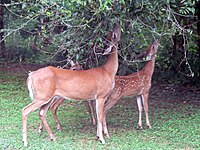
Photo from wikipedia
Associational resistance theory predicts that insect herbivory decreases with increasing tree diversity in forest ecosystems. However, the generality of this effect and its underlying mechanisms are still debated, particularly since… Click to show full abstract
Associational resistance theory predicts that insect herbivory decreases with increasing tree diversity in forest ecosystems. However, the generality of this effect and its underlying mechanisms are still debated, particularly since evidence has accumulated that climate may influence the direction and strength of the relationship between diversity and herbivory.We quantified insect leaf herbivory and leaf chemical defences (phenolic compounds) of silver birch Betula pendula in pure and mixed plots with different tree species composition across 12 tree diversity experiments in different climates. We investigated whether the effects of neighbouring tree species diversity on insect herbivory in birch, that is, associational effects, were dependent on the climatic context, and whether neighbour-induced changes in birch chemical defences were involved in associational resistance to insect herbivory.We showed that herbivory on birch decreased with tree species richness (i.e. associational resistance) in colder environments but that this relationship faded as mean annual temperature increased.Birch leaf chemical defences increased with tree species richness but decreased with the phylogenetic distinctiveness of birch from its neighbours, particularly in warmer and more humid environments.Herbivory was negatively correlated with leaf chemical defences, particularly when birch was associated with closely related species. The interactive effect of tree diversity and climate on herbivory was partially mediated by changes in leaf chemical defences.Our findings confirm that tree species diversity can modify the leaf chemistry of a focal species, hence its quality for herbivores. They further stress that such neighbour-induced changes are dependent on climate and that tree diversity effects on insect herbivory are partially mediated by these neighbour-induced changes in chemical defences.
Journal Title: Functional ecology
Year Published: 2021
Link to full text (if available)
Share on Social Media: Sign Up to like & get
recommendations!